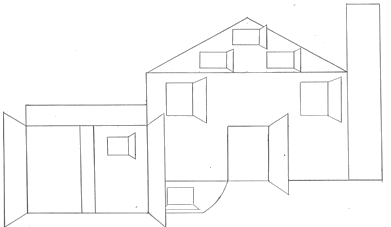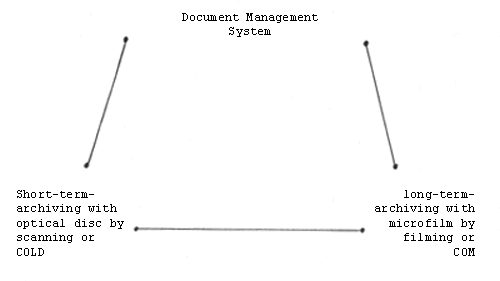|
|
24. |
Eckstein, D.: Demands of justice to a long-term record - a report in the point of view in practice microfilm taking into consideration medical questions in Germany |
Outline:
There is no doubt: In German laws the existence of the term" electronic means" is rare. In contrary to this you'll often find "carrier of picture" (according to the term "film" or "microfilm"). So we see in practice an acceptance of film, retrospectively too. Today, in a time of growing up of electronical means by itself and the combination with microfilm (German term "Hybrid-System") or in COM (computer-output-microfilm) laws in Germany have lost the possibility of innovation, indeed. Looking forward to getting closer and to Co-existing of electronic and non-electronic means for filing we see risks altogether. So, reporting of long-year learning by using microfilm in this publication we'll give an example of electronic means. That is why, too, the doing by the people of electronic industries to laws must be seen critically. Success was not given until today. 2. Presently existence of the term "carrier of picture" and "other carriers of data" See following tables. German laws are "freely" translated into English language, please. You've seen: Electronical means doesn't exist in laws, only by an ordinance of using in an order (!). 3. Report in the point of view in practice microfilm Early using film - that means film copies and microfilm and so on (legal notion: "carrier of picture") by code of civil process (see appendage) was done without doing of microfilm industry. The extreme shortage of space in archives of the courts of justice was the motive looking for a trust worthy mean, which makes information smaller. In this way microfilm was found. This acceptance by German law courts found the microfilm industry satisfied. Today we'll say comprehensively the way was right and sufficent. In "sensitive" medical data there's the same. No legal problems we summarized by an inquiry 1994 (1). Even it was reported that by public prosecutors the microfilm of x-ray photograph has been taken instead of the original picture (2). 4. Problem long-term archiving Here is fundamental the § 195 of the civil code (see appendage). This paragraph is called "Regular period of prescription" and it means 30 years. 5. Specific question patient care In contrast to other branches of business in patient care you must get 30 years documentation time. This is why here the subject is the human being itself (the patient) and so grave states of affairs seems possibile, for instance actions for damages and even killing. In conclusion, the 30 years corresponding to 5 195 of the civil code are intended for all patient-related information (3). Nevertheless you'll see in Germany some attempts to make smaller this time. In the "order of x-ray" from 8.1.1987 the archiving time of x-ray diagnostic film seems to be 10 years. We think, this is wrong, § 195 civil code is dominating here, too. And there is a second problem. In actions for damages in Germany primary the load of evidence is being by the patient. In the case of missing of documents in filing the load of evidence is getting by the doctor or the hospital now and the possibility of loosing the process is real (4) . So, we think, there is a need of a mean for long-term archives with real security to 30 years. But there's another fact in patient care, often not taken in consideration: following a lost process is also strictly following a lost of reputation. It is somewhat bigger in accordance to a similar fact in the industry. The damage can become so large, that bankruptcy for hospital or doctors is getting real. 6. Discussion We must see above that the appearing of electronic means in German laws is very insufficient. Today, living in the "information period" we cannot understand the situation, and this is in contrast to the high activity for acceptance by law courts from industries or various institutions, too. One of the first attempt was aimed at changing the so-called "erasing paragraphs" § 239, part 3, code of commerce [Writing of the books of commerce] and §146, part 4, order of tax [Directions for book-keeping and recording]. Success was not given, the laws are strongly in Germany, a small possibility of changing a document may not happen. Next target was the idea "document" of the civil code, a stronger regulation. In a summary, it is the opinion of the author and others, that these targets must be seen critically. Why they go to security and long-term archiving? The strength of electronic means exists on other fields. Technical possibilities of data transfer are enormous, but this is at the same time a spring for lost of data and non-authorized grip. Wide opening of doors and windows of a house makes it not sure, indeed (picture 1). We all know the long history of data lost by computers from banking, even Ministries of defense and so on. So , in conclusion, the powers of electronic means, such as data transfer, should be taken in the middle of the doing. In contrast, long-term archiving is not the target, that is why security for 30 years must be guaranteed. But, what about "solid" optical discs? These means don't exist alone, too , there is software, there are the men and so the possibilities of errors, it goes without saying. Following this fact data lost has happened by converting an optical disc in a bank in U.K. due to error of the software 1995 (5). In patient care recording may be in a combination of various means (picture 2 ). So, we think, that a better target for electronic means seems to be the transfer of data and short-term archiving to get better acceptance by the courts of justice. To the last initiative to "digital signature" a few weeks ago we're looking forward hopefully (6). With regard to tactics we offer the following: The best of all situations you can see, if the law courts and similiar institution are calling by themselves for a solution. The transfer of data through police and public prosecutors seems to be an example. In patient care we should talk about the case of emergency, for instance the living-necessary consultation with fracture of the skull, including pictures of computertomographs from one hospital to a second one. First of all this is a case for doctors and not for the law institutions. The patient is coming with "help me quickly". Therefore the system should be built "to the life" by the oath of doctors and questions of data protection and others are here secondary. Here is to help the doctor's doing and not to be in the way. 7. Summary Acceptance of electronic means by German law courts is low. By long-year learning in using microfilm we'll give an example of electronic means for improving the situation. The recommendation is given, that the data transfer should be the target and not the long-term archiving. With regard to tactics it is to say, that's the best, if the law courts and similar institutions are calling by themselves for a solution. LITERATUR (in German)
Translation of notations from German laws and orders in English
table: "carrier of picture" and electronic means in German laws and orders
picture 1: How to get security - at the same time? 
picture 2: A modern combination of records for a hospital 
Epilog nach Inkrafttreten des Gesetzes zur digitalen Signatur Die Einführung des Gesetzes ist deswegen schon ein wesentlicher Fortschritt, weil Begriffe von elektronischen Medien nun auch im juristischen Sinne auftauchen. Primär ist jedoch einzuwenden, daß ein Einbau in "höherwertige Gesetze" wie 2.B. entsprechend im BGB, der ZPO, dem HGB u.a. nicht erfolgt. So stellt der Gesetzgeber (bewusst) keinen Bezug zum Urkundenbegriff her, er verwendet den Terminus "eigenhändige Unterschrift" nicht und setzt dafür "elektronische Signatur" ein. Bestrebungen, die Richterschaft aufzufordern, dass ein mit elektronischer Signatur gesiegeltes Dokument als Urkunde anzusehen sei, sollten unterbleiben. Es besteht nämlich so die Gefahr, dass man ein neues Gesetz bereits in der Phase der praktischen Bewährung sozusagen totredet. In den USA gibt es dazu reichlich negative Erfahrungen mit dem Rule 1001 (3). Sollte man sich nun mit dem Wortlaut zufriedengeben? Diese Frage ist prinzipiell zu bejahen, keine Aktivitäten in Richtung "Urkunde" (s. oben), keine Änderung der sogenannten Radierparagraphen § 239 (Abs. 3) HGB und § 146 (Abc. 4) A0 sowie keine Versuche hinsichtlich des Einsatzes von elektronischen Medien als Langzeitspeicher mit 30 Jahren und mehr. Es ist allerdings zu raten, das neue Gesetz auf seine Belastung in der Praxis zu überprüfen. zurück |